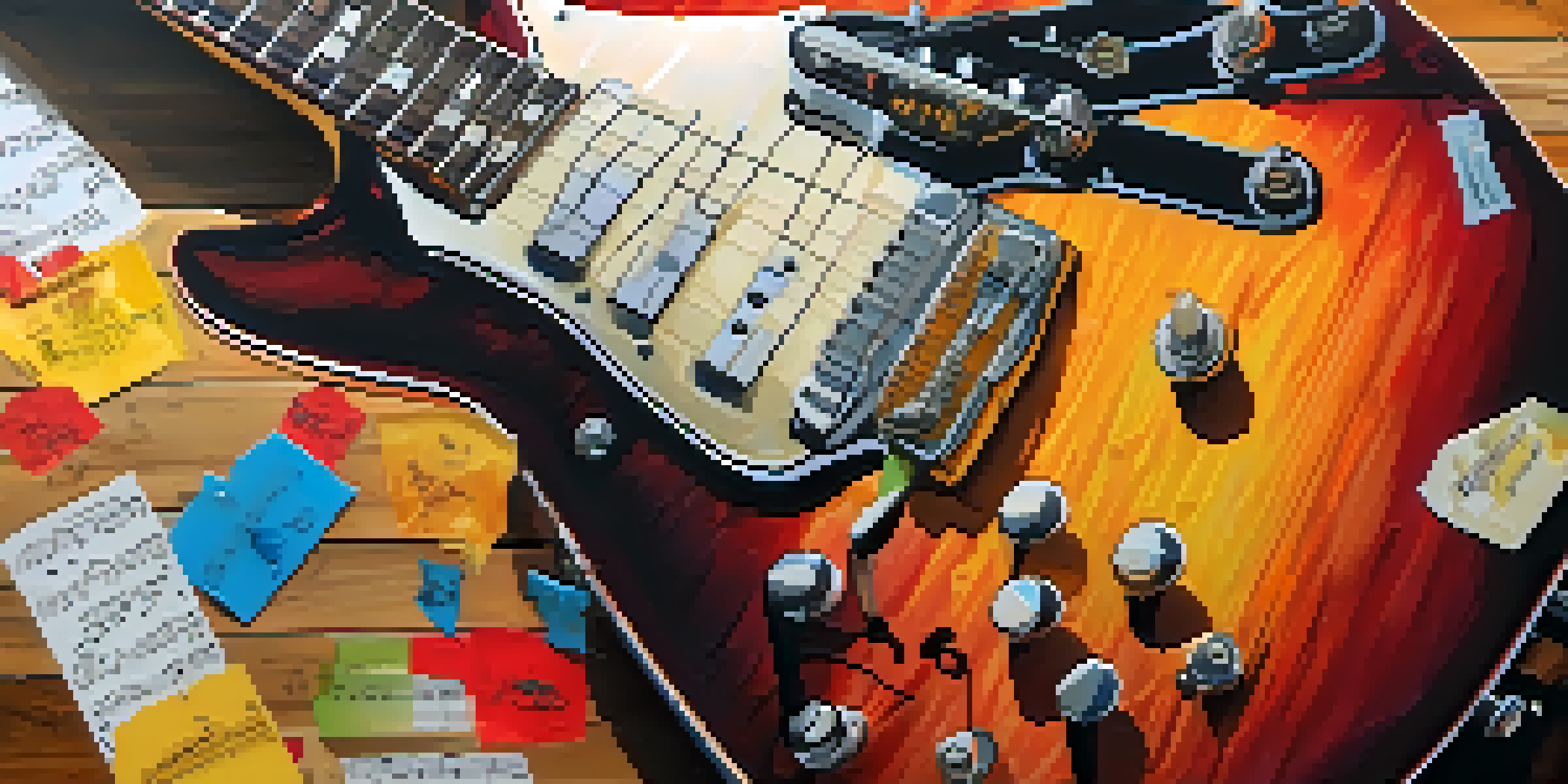Writing Guitar Riffs That Capture Listener's Attention

Understanding the Essence of a Great Guitar Riff
At its core, a great guitar riff is more than just a series of notes; it’s a memorable musical idea that sticks with the listener. Think of it as a musical hook that draws people in, much like an engaging opening line in a novel. The best riffs often blend simplicity and creativity, making them easy to remember yet distinctive enough to stand out.
The guitar is the easiest instrument to play and the hardest to play well.
Take the iconic riff from 'Smoke on the Water' by Deep Purple as an example. Its straightforward melody is instantly recognizable, showcasing how effective simplicity can be. A well-crafted riff can evoke emotions and set the tone for the entire song, making it a crucial element for any guitarist to master.
Ultimately, understanding what makes a riff compelling is the first step in writing one that captures your audience’s attention. It’s about creating something that resonates, making listeners want to replay it over and over.
Choosing the Right Scale for Your Riff
The choice of scale can greatly influence the mood and feel of your riff. Major scales often convey happiness and brightness, while minor scales might evoke a sense of melancholy or tension. For example, using a pentatonic scale is popular in rock and blues music due to its versatility and ease of use, making it a great starting point for riff creation.

Experimenting with different scales can lead to unexpected and exciting results. Imagine crafting a riff in a Dorian mode, which offers a unique flavor that can set your music apart. By exploring various scales, you can find the perfect sound that aligns with the emotions you want to express.
Crafting Memorable Guitar Riffs
A great guitar riff is a blend of simplicity and creativity that resonates with listeners, much like an engaging opening line in a novel.
Incorporating different scales into your riffs not only enhances creativity but also allows you to connect with your audience on a deeper level. It’s about finding that sonic signature that resonates with listeners and keeps them engaged.
Creating Catchy Rhythmic Patterns
Rhythm is just as important as melody when it comes to writing a captivating riff. A catchy rhythmic pattern can make even the simplest notes stand out. Think of the difference between a straight eighth note pattern and a syncopated rhythm; the latter can add a layer of intrigue and excitement to your riff.
Music can change the world because it can change people.
For instance, consider the infectious groove of 'Sweet Child O' Mine' by Guns N' Roses. Its unique rhythmic phrasing enhances the melodic line, making it more engaging. By playing around with different rhythms, you can find a groove that complements your melody and keeps listeners tapping their feet.
Ultimately, rhythm adds the dynamic pulse to your riffs, creating a sense of movement that draws listeners in. Don’t underestimate the power of a well-placed rest or a swing feel—it can transform a good riff into a great one.
Incorporating Unique Techniques for Impact
Adding unique guitar techniques can elevate your riff from ordinary to extraordinary. Techniques like hammer-ons, pull-offs, bends, and slides can create a richer sound and add personality. For example, a well-placed bend can convey emotion, while a slide can create a sense of fluidity in your playing.
Think about how Jimi Hendrix employed feedback and distortion to craft his signature sound. His innovative use of techniques transformed the way guitarists approached riff writing. By experimenting with various techniques, you can create textures and effects that captivate your audience.
The Power of Rhythm in Riffs
Catchy rhythmic patterns enhance melodies, making riffs more engaging and dynamic, as seen in iconic songs like 'Sweet Child O' Mine.'
Incorporating these techniques not only showcases your skills but also adds depth and interest to your riffs. It’s about breaking the mold and creating something that feels fresh and exciting.
Building Tension and Resolution in Your Riff
Creating a sense of tension and resolution is essential for keeping listeners engaged. This can be achieved by strategically placing dissonant notes or using dynamics to build anticipation. For instance, you might start with a riff that builds tension before resolving to a satisfying chord or melody, similar to how a good story creates suspense before revealing the conclusion.
Consider how Led Zeppelin’s 'Whole Lotta Love' uses tension effectively throughout its iconic riff. The interplay between the verses and the chorus creates a compelling dynamic that keeps listeners on their toes. By mastering the art of tension and resolution, you’ll find that your riffs can evoke a range of emotions.
Ultimately, the ability to create and release tension is what makes a riff memorable. It invites listeners on a journey, making them eager to hear what comes next.
Experimenting with Different Genres
Diving into various musical genres can provide fresh inspiration for your riffs. Each genre has its own set of characteristics, and exploring them can help you discover new sounds and techniques. For example, a funk riff might incorporate syncopation and rhythmic accents, while a metal riff could focus on speed and aggression.
Take the time to listen to a variety of styles, from jazz to reggae, and see how their distinct elements can influence your own writing. This can lead to innovative combinations, like merging rock with funk to create a unique sound. The more you experiment, the more you’ll discover what resonates with you and your audience.
Refining Through Feedback
The process of refining a riff, including seeking feedback and making revisions, is crucial for creating a memorable final product.
By blending genres, you not only expand your musical vocabulary but also create something that stands out. It's an exciting way to keep your riffs fresh and engaging.
Refining Your Riff Through Feedback and Revision
Writing a great riff often involves a process of refinement. After you’ve crafted your initial idea, it’s crucial to step back and evaluate it. Seeking feedback from fellow musicians or friends can offer new perspectives and help you identify areas for improvement.
Don’t be afraid to make revisions; sometimes, the most memorable riffs emerge from tweaking and reworking initial ideas. For instance, you might change a note or adjust the rhythm to enhance its catchiness. Remember, many iconic riffs didn’t come together perfectly on the first try.

Ultimately, the process of refining your riff is just as important as the initial creation. Embracing feedback and being willing to revise can lead to a final product that truly captivates your audience.